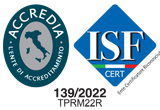
EuroNCAP, safer cars for the last 20 years
Paolo Ferrini
78,000 lives saved, 1,800 vehicles tested, 630 safety ratings, investments for 160 million euro. Result: safer cars than ever before. And from next year impact tests on cyclists.
EuroNCAP, the international car safety assessment project on new cars, with Automobile Club Italy as a partner, celebrates its 20 years of activity this year. We have to go back to February 4, 1997 when, in Europe, car safety officially became a central topic. Before that, in fact, car manufacturers were required to comply with the minimum legal requirements, but the results of the crash tests performed internally on new models to be launched on the market were never made public. Then came the 'EuroNCAP' (European New Car Assessment Program), an independent body that started testing cars according to certain safety parameters and subsequently raised safety standards, demonstrating the effects of an impact on a particular model and forcing manufacturers to improve passenger safety.
"The first few tests highlighted a number of serious flaws in the safety features of some of the most popular cars", recalls Michiel Van Ratingen, Secretary General of EuroNCAP, "which compelled all manufacturers to rethink the way vehicles were designed to prevent accidents and save lives". Since then, the stars assigned by this testing authority, have become the most important parameter consumers can look at in choosing a model over another. And the highest score - 5 stars - is now to be considered a sort of guarantee mark used by the same car manufacturers to enhance their products.
EuroNCAP's 20 years of activity represents a push towards greater road safety-oriented technologies, and as a result, at least 78,000 lives have been saved by safety devices that have been developed, tested and installed on our cars. "Some safety technologies, which did not exist or were optional at best - such as driver and passenger airbags, side airbags, safety belts, and electronic stability control - are now standard in all cars sold throughout Europe", according to EuroNCAP personnel. "This institution has given millions of consumers the opportunity to choose, with great confidence, the safest car available on the market," says Van Ratingen. "However, in recent years, a rather troubling decline has taken place in the pace at which new and innovative safety devices have been introduced, prompting us not to lower the guard. We want to make sure that in the next 20 years Europe's roads become even safer: not just for motorists, but for all road users. We are already testing many other aspects of vehicle safety; more than we did back in 1997 and we are committed to continue in this direction. Next year we will test systems that recognize and avoid impact with cyclists and we are planning a particularly demanding roadmap for the 2020-2025 five-year period".
Getting a 5 star rating is not easy. Not only the safety of the car’s occupants is verified in case of impact (with a variety of tests: front, side and rear-end collision...): a number of features are taken into account such as the safety of children on-board and pedestrians accidentally run-over. Electronic assistance systems such as automatic emergency braking or anti-collision systems are paramount.
Accident simulations reproduce real situations and measure the vehicle's ability to avoid impact (braking space, stability). In the event that the accident is inevitable, potential damages to the human body are detected by means of special dummies equipped with a number of sensors that reproduce the effects of the accident, thus recording the level of safety for the passengers, based on weight and height, simulating adults and children, men and women. The score thus obtained is then translated into safety ratings and resulting stars for each category.
To date, more than 1,800 vehicles have been tested and 630 security ratings have been issued for a total investment of over 160 million Euro. "We are very proud of the fact that our program has led to significant improvements in vehicle safety and has made Europe the region with the lowest rate of fatal accidents", concludes Van Ratingen. "Yet, on figures, still much remains to be done".
"The first few tests highlighted a number of serious flaws in the safety features of some of the most popular cars", recalls Michiel Van Ratingen, Secretary General of EuroNCAP, "which compelled all manufacturers to rethink the way vehicles were designed to prevent accidents and save lives". Since then, the stars assigned by this testing authority, have become the most important parameter consumers can look at in choosing a model over another. And the highest score - 5 stars - is now to be considered a sort of guarantee mark used by the same car manufacturers to enhance their products.
EuroNCAP's 20 years of activity represents a push towards greater road safety-oriented technologies, and as a result, at least 78,000 lives have been saved by safety devices that have been developed, tested and installed on our cars. "Some safety technologies, which did not exist or were optional at best - such as driver and passenger airbags, side airbags, safety belts, and electronic stability control - are now standard in all cars sold throughout Europe", according to EuroNCAP personnel. "This institution has given millions of consumers the opportunity to choose, with great confidence, the safest car available on the market," says Van Ratingen. "However, in recent years, a rather troubling decline has taken place in the pace at which new and innovative safety devices have been introduced, prompting us not to lower the guard. We want to make sure that in the next 20 years Europe's roads become even safer: not just for motorists, but for all road users. We are already testing many other aspects of vehicle safety; more than we did back in 1997 and we are committed to continue in this direction. Next year we will test systems that recognize and avoid impact with cyclists and we are planning a particularly demanding roadmap for the 2020-2025 five-year period".
Getting a 5 star rating is not easy. Not only the safety of the car’s occupants is verified in case of impact (with a variety of tests: front, side and rear-end collision...): a number of features are taken into account such as the safety of children on-board and pedestrians accidentally run-over. Electronic assistance systems such as automatic emergency braking or anti-collision systems are paramount.
Accident simulations reproduce real situations and measure the vehicle's ability to avoid impact (braking space, stability). In the event that the accident is inevitable, potential damages to the human body are detected by means of special dummies equipped with a number of sensors that reproduce the effects of the accident, thus recording the level of safety for the passengers, based on weight and height, simulating adults and children, men and women. The score thus obtained is then translated into safety ratings and resulting stars for each category.
To date, more than 1,800 vehicles have been tested and 630 security ratings have been issued for a total investment of over 160 million Euro. "We are very proud of the fact that our program has led to significant improvements in vehicle safety and has made Europe the region with the lowest rate of fatal accidents", concludes Van Ratingen. "Yet, on figures, still much remains to be done".




















